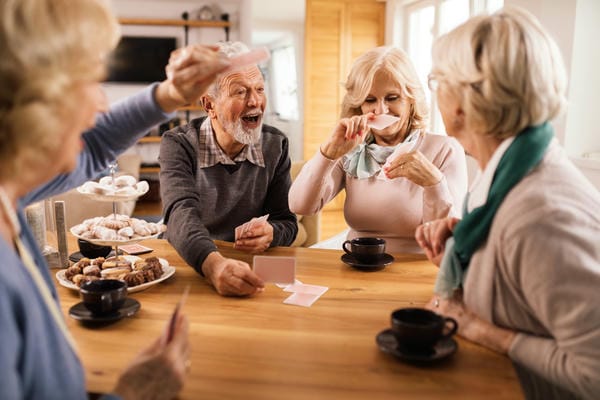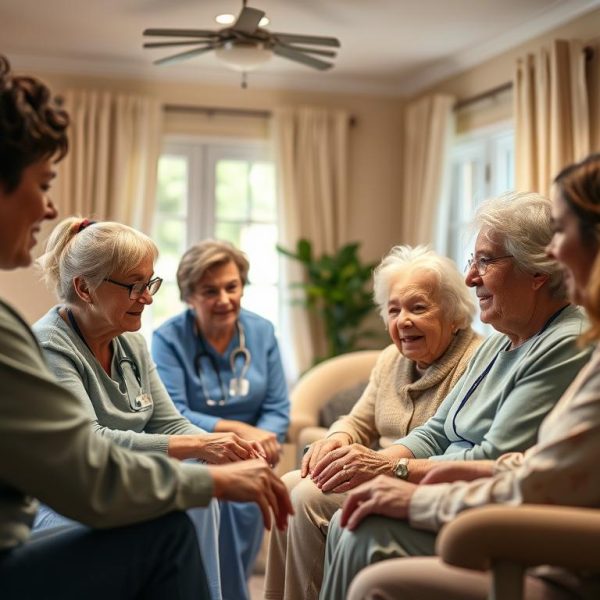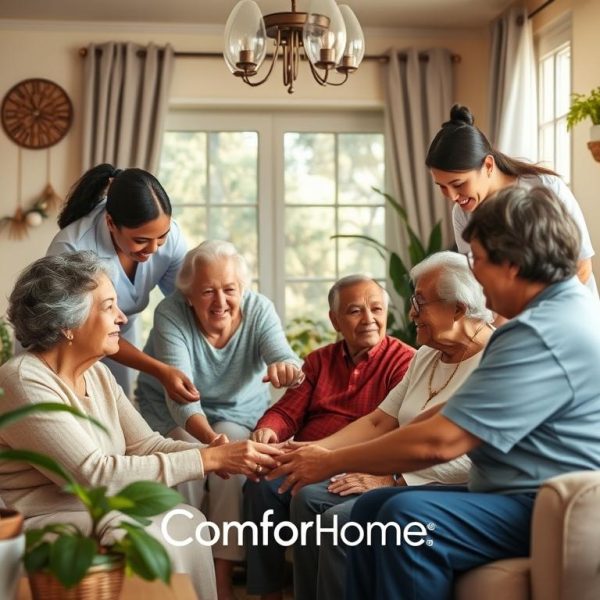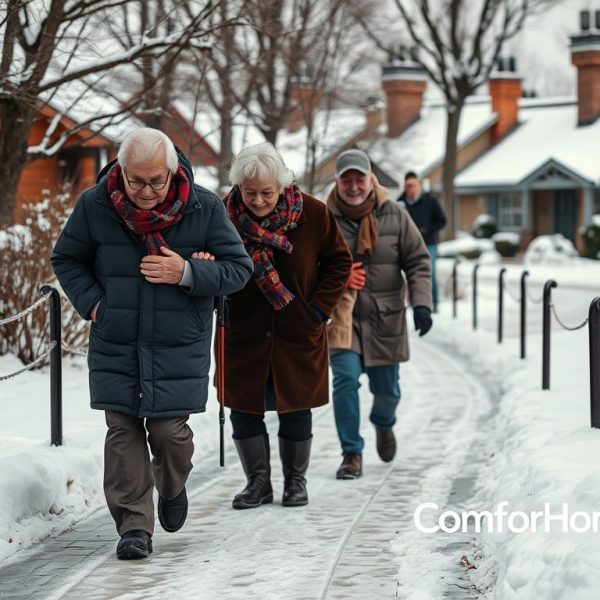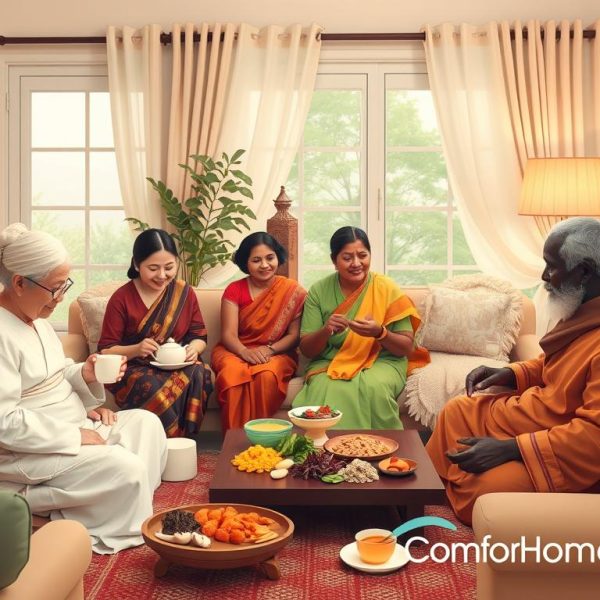Are you concerned about the mental well-being of seniors in your life? Social interaction could be the key to unlocking a happier, healthier future for older adults. In this expert guide, we’ll explore 10 proven ways that social engagement can boost mental health in seniors, backed by scientific research and real-world experience.
From maintaining family connections to embracing technology, we’ll uncover strategies that can:
• Enhance cognitive function and brain health
• Combat social isolation and loneliness
• Improve overall quality of life and well-being
Whether you’re a caregiver, family member, or senior yourself, this comprehensive guide will equip you with practical tips to foster meaningful social connections and promote mental wellness in older adults. Let’s dive in and discover how social interaction can be a powerful tool in supporting the mental health of our beloved seniors.
The Importance of Social Interaction for Senior Mental Health
Did you know that social connections can be as vital for seniors as their daily medication? It’s true! Social interaction plays a crucial role in maintaining and enhancing mental health among older adults.
Imagine a garden. Just as plants need water and sunlight to thrive, seniors need social connections to keep their minds sharp and spirits high.
But why is this so important?
Well, regular social interactions can help seniors:
Combat Loneliness
Loneliness isn’t just a feeling – it can have real health consequences. Engaging with others helps ward off the blues and keeps seniors connected to the world around them.
Stimulate the Mind
Conversations, shared activities, and new experiences all help keep the brain active and alert. It’s like a mental workout!
Boost Mood
Laughter with friends, sharing stories, or simply enjoying company can lift spirits and improve overall well-being.
Provide Purpose
Social connections give seniors a reason to get up and get going each day, providing structure and meaning to their lives.
Think about your favorite older relative. Don’t you want them to have a rich, fulfilling social life? That’s what we’re aiming for here!
💡 Key Takeaways: Social interaction is a cornerstone of mental health for older adults, providing cognitive stimulation, emotional support, and a sense of purpose in life.
Understanding Social Isolation in Seniors
Picture this: An elderly neighbor who rarely leaves their home, with few visitors and little contact with the outside world. This is social isolation, and it’s more common – and dangerous – than you might think.
Social isolation isn’t just about being alone. It’s about a lack of meaningful social connections and can lead to serious health issues.
Here’s why it’s so concerning:
Increased Health Risks
Research shows that social isolation can be as harmful to health as smoking 15 cigarettes a day. It can increase the risk of heart disease, depression, and even premature death.
Physical Inactivity
When seniors are isolated, they’re less likely to engage in physical activities. This can lead to a decline in overall health and mobility.
Cognitive Decline
Without regular social stimulation, cognitive abilities can deteriorate faster. It’s like letting a muscle waste away from disuse.
Recognizing the signs of social isolation is the first step in addressing this serious issue. Let’s work together to keep our seniors connected and thriving!
💡 Key Takeaways: Social isolation in seniors is a serious concern that can lead to increased health risks, physical inactivity, and accelerated cognitive decline.
The Link Between Social Engagement and Cognitive Function
Ever heard the phrase “use it or lose it”? Well, it applies to our brains too, especially as we age. And guess what? Social engagement is like a super-fuel for our cognitive function!
Let’s break it down:
Brain Workout
Every time we engage in a conversation, play a game with friends, or participate in a group activity, our brains are getting a workout. It’s like going to the gym, but for your mind!
Memory Boost
Social interactions often involve recalling past events, remembering names, and learning new information. This constant mental exercise helps keep our memory sharp.
Problem-Solving Skills
Navigating social situations requires quick thinking and adaptability. Whether it’s deciding what to cook for a potluck or figuring out the rules of a new game, these challenges keep our problem-solving skills in top shape.
Emotional Regulation
Interacting with others helps us practice emotional control and empathy, key components of cognitive function.
Research backs this up too. A study published in the Journal of Gerontology found that seniors with a larger social network had better cognitive function and a slower rate of cognitive decline.
So, next time you’re chatting with your elderly aunt or playing cards with your grandpa, remember – you’re not just having fun, you’re boosting brain health!
💡 Key Takeaways: Social engagement acts as a powerful stimulant for cognitive function in seniors, improving memory, problem-solving skills, and emotional regulation while slowing cognitive decline.
10 Proven Ways to Boost Mental Health Through Social Interaction
Ready to supercharge your senior loved one’s social life? Here are 10 expert-backed strategies that can make a world of difference:
1. Maintaining Regular Family Connections
Nothing beats the warmth of family, right? Regular family gatherings, whether in person or virtual, can be a lifeline for seniors.
Try these:
– Weekly family dinners
– Video calls with distant relatives
– Creating a family photo album together
Remember, even a quick daily phone call can brighten a senior’s day and keep them connected to their loved ones.
2. Joining Community Groups and Activities
Community involvement is like a social buffet – there’s something for everyone!
Consider these options:
– Book clubs for avid readers
– Gardening groups for nature lovers
– Art classes for creative souls
Joining these groups not only provides social interaction but also a sense of belonging and purpose.
3. Attending Social Events and Gatherings
Who said the party stops after 60? Social events can be a great way for seniors to mingle and have fun.
Some ideas include:
– Senior proms or dances
– Community picnics
– Holiday celebrations
These events offer opportunities to meet new people and strengthen existing friendships.
4. Volunteering Opportunities for Seniors
Volunteering is a win-win: it helps others while boosting the volunteer’s mental health.
Popular options include:
– Reading to children at local libraries
– Helping at animal shelters
– Assisting at community food banks
Volunteering provides a sense of purpose and the joy of giving back to the community.
5. Engaging in Cognitive-Enhancing Activities
Let’s keep those brain cells firing! Cognitive activities combined with social interaction are a powerful duo.
Try these:
– Group crossword puzzles
– Chess or bridge clubs
– Learning a new language with friends
These activities stimulate the mind while fostering social connections.
6. Utilizing Technology for Social Connections
In our digital age, technology can be a powerful tool for staying connected.
Some tech-savvy ideas:
– Social media groups for seniors
– Online multiplayer games
– Virtual book clubs or cooking classes
Technology can help maintain existing friendships and forge new ones, regardless of physical distance.
7. Participating in Support Groups
Sometimes, sharing experiences with others who understand can be incredibly therapeutic.
Consider groups focused on:
– Chronic health conditions
– Bereavement
– Retirement adjustment
These groups offer emotional support and practical advice from peers facing similar challenges.
8. Physical Activities with Social Components
Who says exercise can’t be fun and social? Group physical activities offer double benefits.
Popular options include:
– Senior yoga classes
– Walking clubs
– Water aerobics
These activities improve physical health while providing opportunities for social interaction.
9. Learning New Skills in Group Settings
It’s never too late to learn something new, especially with friends!
Exciting options might include:
– Cooking classes
– Photography workshops
– Ballroom dancing lessons
Learning together creates shared experiences and topics for conversation.
10. Pet Ownership and Animal Therapy
Furry friends can be great companions and social catalysts.
Consider:
– Adopting a pet (if able to care for one)
– Participating in animal therapy programs
– Joining a dog walking group
Pets provide companionship and can facilitate social interactions with other animal lovers.
Remember, the key is finding activities that resonate with the individual senior’s interests and abilities. It’s not about quantity, but quality of social interactions.
💡 Key Takeaways: Implementing a variety of social activities tailored to a senior’s interests can significantly boost their mental health and overall well-being.
The Role of Senior Living Communities in Promoting Social Interaction
Ever wondered why senior living communities are becoming increasingly popular? It’s because they’re like social hubs designed specifically for older adults!
These communities offer a wealth of opportunities for social interaction:
Built-in Social Network
Imagine living in a place where your neighbors are potential friends, all in a similar life stage. That’s what senior living communities offer!
Organized Activities
From movie nights to fitness classes, these communities often have a packed calendar of events. It’s like being on a cruise ship, but on land!
Shared Spaces
Common areas like dining rooms, game rooms, and gardens encourage spontaneous interactions. It’s like having a coffee shop and park right in your building.
Support Services
Staff members often facilitate social connections, helping residents find others with similar interests. Think of them as friendly matchmakers for friendships!
For example, Mrs. Johnson, a 75-year-old widow, was feeling isolated in her old home. After moving to a senior living community, she joined a knitting club, made new friends at communal dinners, and even started teaching a watercolor class!
These communities make it easy for seniors to stay socially active, which in turn supports their mental health and overall well-being.
💡 Key Takeaways: Senior living communities provide a supportive environment that naturally fosters social interaction, offering numerous opportunities for residents to engage with peers and maintain an active social life.
Overcoming Barriers to Social Engagement for Seniors
Let’s face it – sometimes staying social isn’t as easy as we’d like it to be. But don’t worry, for every obstacle, there’s a solution!
Mobility Issues
Challenge: Physical limitations can make it hard to get out and about.
Solution: Look into transportation services for seniors or online social groups. Even a friendly visitor program can bring social interaction right to their doorstep!
Hearing or Vision Impairments
Challenge: These can make communication difficult and frustrating.
Solution: Encourage the use of hearing aids or visual aids. Choose quieter settings for get-togethers. Remember, patience goes a long way!
Technology Intimidation
Challenge: The digital world can seem overwhelming.
Solution: Consider tech classes designed for seniors. Many libraries offer these for free! Start with user-friendly devices like tablets.
Loss of Old Friends
Challenge: As we age, we may lose connections due to various reasons.
Solution: Encourage joining new groups based on interests. It’s never too late to make new friends!
Depression or Anxiety
Challenge: These conditions can make social interaction seem daunting.
Solution: Seek professional help. A therapist can provide strategies to manage these feelings and gradually increase social engagement.
Remember, it’s okay to start small. Even a brief chat with a neighbor or a short phone call can be a positive step towards a more socially active life.
💡 Key Takeaways: While barriers to social engagement exist for seniors, they can be overcome with the right strategies, support, and a willingness to try new approaches to staying connected.
The Impact of Social Interaction on Overall Well-being and Quality of Life
Picture this: A garden where some plants are nurtured daily, while others are left alone. Which do you think will flourish? Just like those plants, seniors thrive with regular social interaction!
Here’s how social connections boost overall well-being:
Physical Health
Believe it or not, socializing can be as good for your body as it is for your mind. Regular social interaction can:
– Lower blood pressure
– Boost immune function
– Encourage physical activity
It’s like a workout for your whole system!
Mental Sharpness
Engaging with others keeps the mind active and alert. It’s like a gym membership for your brain, helping to:
– Improve memory
– Enhance problem-solving skills
– Stimulate creativity
Emotional Well-being
Human connection is food for the soul. Social interaction can:
– Reduce feelings of loneliness and depression
– Increase self-esteem and confidence
– Provide a sense of belonging and purpose
Stress Reduction
Sharing experiences and feelings with others can be a great stress-buster. It’s like having a pressure release valve for life’s challenges.
Longer Life
Studies show that socially active seniors tend to live longer. It’s as if friendship has a secret ingredient for longevity!
Remember Mrs. Davis? At 80, she joined a local knitting circle. Not only did she make new friends, but she also reported feeling more energetic, sleeping better, and having a more positive outlook on life.
So, let’s toast to the power of social connections – they truly are the secret sauce for a high quality of life in our golden years!
💡 Key Takeaways: Regular social interaction significantly enhances seniors’ overall well-being, positively impacting physical health, mental sharpness, emotional well-being, stress levels, and even longevity.
Cultural Considerations in Promoting Social Interaction Among Seniors
When it comes to social interaction, one size doesn’t fit all. Just like a world map, the landscape of senior socialization is diverse and colorful!
Here’s why culture matters:
Family Dynamics
In some cultures, multi-generational living is the norm. For others, independence is highly valued. Understanding these differences helps in creating appropriate social opportunities.
Language Preferences
For seniors who are more comfortable in their native language, finding social groups that speak their language can be crucial.
Traditional Activities
What’s considered fun and engaging can vary widely between cultures. While bingo might be popular in one community, mahjong could be the go-to in another.
Religious Practices
For many seniors, religious gatherings are a primary source of social interaction. Respecting and incorporating these practices is essential.
Food and Celebrations
Cultural festivals and food-centric gatherings can be great ways to promote social interaction while honoring cultural traditions.
Remember Ms. Z? She struggled to connect in her retirement community until they started a weekly “International Food Night”. Suddenly, she was the star, teaching others how to make her famous dumplings!
By considering these cultural factors, we can create more inclusive and effective social programs for all seniors.
💡 Key Takeaways: Recognizing and respecting cultural differences is crucial in developing effective strategies for promoting social interaction among diverse senior populations.
The Role of Healthcare Providers in Encouraging Social Engagement
Think of healthcare providers as the conductors of an orchestra, harmonizing various aspects of senior health – including social engagement!
Here’s how they can play this crucial role:
Screening for Social Isolation
During regular check-ups, providers can assess a senior’s social connections. It’s like taking the temperature of their social life!
Prescribing Social Activities
Just as they prescribe medications, providers can recommend social activities tailored to the individual’s interests and abilities.
Connecting to Resources
Healthcare providers can be a bridge to community resources, support groups, and social services. They’re like GPS for navigating the social landscape!
Educating About Benefits
Providers can explain the health benefits of social engagement, motivating seniors to stay connected. It’s like giving them a roadmap to better health!
Addressing Barriers
Whether it’s hearing loss or mobility issues, providers can help address physical barriers to social interaction.
For instance, Dr. Smith noticed her patient, Mr. Johnson, was becoming withdrawn. She connected him with a local senior center and a hearing specialist. Six months later, Mr. Johnson was leading a weekly chess club!
Remember, the Uprise Health EAP member portal and recent CDC publications are great resources for healthcare providers looking to support senior social health.
💡 Key Takeaways: Healthcare providers play a pivotal role in promoting social engagement among seniors by screening, recommending activities, connecting to resources, educating, and addressing barriers to social interaction.
Future Directions: Research and Interventions for Senior Social Health
Imagine a future where loneliness in seniors is as rare as a typewriter in a modern office. We’re not there yet, but exciting developments are on the horizon!
Here’s what’s cooking in the world of senior social health:
Tech-Savvy Solutions
Research is exploring how virtual reality and AI can create immersive social experiences for homebound seniors. It’s like bringing the world to their living room!
Intergenerational Programs
Studies are showing promising results from programs that connect seniors with younger generations. It’s a win-win, providing seniors with purpose and young people with wisdom!
Community Design
Urban planners are researching how to design age-friendly communities that naturally foster social interaction. Imagine neighborhoods built for connection!
Personalized Social Prescriptions
Just as we have personalized medicine, researchers are working on tailored social engagement plans based on individual needs and preferences.
Early Intervention
Studies suggest that promoting social health earlier in life could have long-term benefits. It’s like saving for retirement, but for your social life!
According to a recent study by the National Institute on Aging, about one-third of adults aged 45 and older feel lonely. This statistic underscores the need for continued research and innovative interventions.
As we move forward, the focus is on creating a world where every senior has the opportunity for meaningful social connections. The future of senior social health looks bright indeed!
💡 Key Takeaways: Future research and interventions in senior social health are focusing on innovative technologies, intergenerational connections, community design, personalized approaches, and early intervention strategies to combat loneliness and promote social well-being among older adults.
Conclusion
As we’ve explored, social interaction plays a pivotal role in boosting mental health for seniors. By implementing these ten proven strategies, older adults can significantly enhance their cognitive function, emotional well-being, and overall quality of life. From maintaining family connections to engaging in community activities, each approach offers unique benefits that contribute to a socially active and fulfilling lifestyle.
Remember, it’s never too late to start fostering meaningful social connections. Whether through technology, support groups, or pet companionship, there are numerous ways for seniors to combat social isolation and reap the rewards of social engagement. By taking proactive steps to stay connected, older adults can safeguard their mental health, boost their immune system, and enjoy a more vibrant, purposeful life.
We encourage you to embrace these strategies and make social interaction a priority in your daily routine. Your mental health and overall well-being will thank you for it. Let’s work together to create a society where every senior can thrive through the power of social connection.
